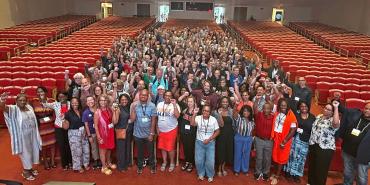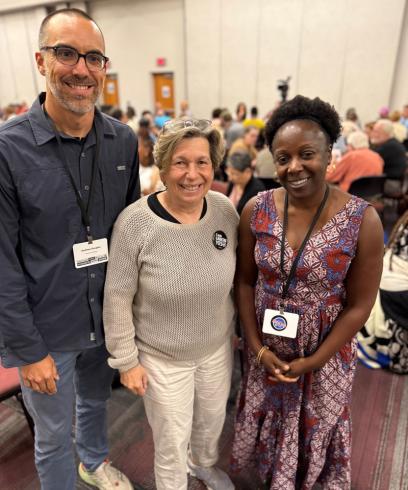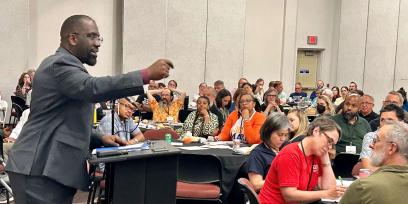AFT higher education workers crowded the halls of Morehouse College in Atlanta July 17-20 for the annual American Association of University Professors/AFT Summer Institute, a four-day intensive of workshops and plenaries that addressed the monumental challenges higher education is facing, and shared training and strategy to meet them.
A joint effort of the AAUP and the AFT, the conference magnified the powerful partnership between the two organizations, welcoming members and leaders from the AFT’s higher education affiliates in all 50 states.
“This is the power of coming together,” said AFT President Randi Weingarten, who also noted the significance of being at Morehouse College, “hallowed ground” where icons of the Civil Rights Movement have convened for generations and where “the potential of multiracial democracy” is so clear.
“Our power is in our numbers,” said AAUP President Todd Wolfson. “These are scary times, but also these are times of opportunity. This is a chance to build the greatest, most powerful higher education labor movement … in the country.” And, he added, “we have an obligation: We have to lead.”
Weingarten said the fact that public education and higher education are “under attack” is well-known; now it is time to focus on “what we do about it.” She warned against attempts to divide people in education and pointed out that higher ed, and education generally, are targets because “we teach knowledge. We teach agency. We teach empowerment.” Critical thinking, problem-solving, empathy, resilience, relationship-building—this work threatens attempts at establishing an authoritarian regime.
The Rev. Dr. Cassandra Gould, political director of Faith in Action National Network, agreed that education is key to winning this fight. She recalled the story that Martin Luther King Jr. told about a college assignment that changed his life: A Morehouse professor told him to read Henry David Thoreau, and he was inspired by Thoreau’s reflections on nonviolent resistance, a principle that became a guiding force and signature belief in his life’s work.
But one needn’t be as prominent as King to make a difference: There are all sorts of roles to play in the resistance, said Gould. Not just in education and labor, but behind-the-scenes work for a movement that is “a coalition of the willing,” even “making sandwiches for those of us who dare to stand in the streets.”
“We need the farmers, the doctors, the businesspeople, the lawyers, the students,” said Maria Stephan, co-lead and chief organizer of the Horizons Project. She described the 3.5 percent rule: “No regime has maintained power when 3.5 percent of the population has engaged in resistance,” she said, pointing to the history of regimes in Chile, South Africa and the Philippines. “There is a long legacy of effective resistance to authoritarianism,” she said.
Stephan also urged participants to go beyond rallies and protests and participate in noncooperation actions. For example, immigrant advocates have urged Avelo Airlines to stop running deportation flights for U.S. Immigration and Customs Enforcement.
Lead and organize
“Everybody’s got a part to play,” said AFT Secretary-Treasurer Fedrick Ingram, who, as a former drum major, understands this credo more deeply than most. He urged conference participants to step up their game: “You might not have a title, but don’t wait your turn to become a leader,” he said. “Don’t shrink your vision. Don’t live in the shadows of a presidency and a government that is going to attack us and attack us and attack us.”
Educators don’t typically go looking for politics, said Ingram, but “politics came looking for us.” Getting involved is essential. “We can’t just go on campus and say that’s my job and I’m done. We have to be activists. And that doesn’t mean just talking about Donald Trump—it means getting involved in the local board of governors and campus politics.”
“Insist upon, keep pushing, do what’s right, organize, organize, organize,” said Ingram. Most importantly, remember, “Power concedes nothing without demand,” he said, quoting Frederick Douglass.
Ingram also praised historically Black colleges and universities, naming Morehouse as the Ivy league of HBCUs and the alma mater of many Black leaders, including Martin Luther King Jr. But HBCUs are all “hurting,” said Ingram, “miserably underfunded by our government.”
A panel of 10 AFT and AAUP members representing HBCUs also acknowledged the recent spike in enrollment at HBCUs, which some attribute to the cost and anti-diversity climate at primarily white institutions.
Choosing an HBCU is often about inclusion: Many on the panel described the discrimination they faced on other campuses. Tamika Baldwin-Clark, from Prairie View A&M University in Texas, said that at primarily white institutions she felt like “just a number” and had to constantly seek out professors to get help, but at Prairie View, “my professors actually sought me out and wanted me to succeed.”
“Every decision I make has a student’s face on it,” said Alvenia Derban from Edward Waters University in Florida, demonstrating that a student-forward approach to teaching is still very much part of the HBCU experience. “We believe in our students, in the intellectual capacity and the brilliance of our students,” said Zoe Spencer-Harris, from Virginia State University.
Increased enrollment at HBCUs is worth celebrating, but it does not come with additional funding, noted Andrew Douglas, vice president of the Morehouse chapter of the AAUP. And pushing students away from primarily white institutions—and into the refuge provided by HBCUs—is resegregating higher education. Douglas urged HBCU members to organize their campuses not just for the sake of higher education, but for the sake of Black students in higher education and for the sake of democracy.
Resistance through organizing
Tales of organizing successes fired up the room as AFT leaders described how they navigated challenging circumstances to win what they needed for their students, their campus communities and themselves. John Miller, president of University Professionals of Illinois, described his union’s journey through a two-year budget crisis under a governor “hell-bent” on defunding higher education as well as labor. The affiliate moved from a service-model union local that was limited to answering members’ requests for help, to an organizing model with a broad-based campaign that eventually won critical funding to help save the state university system from complete collapse.
Much of the success was due to collaboration and creative campaigning. There were teach-ins on the train, marches down the highway, press conferences, yard signs and a powerful partnership with the Chicago Teachers Union. “It was the process of organizing that gave us the power to do what we needed to do,” said Miller. “We transitioned in a short period of time from an organization that was a service-based organization to one that was a mobilized campus.”
Eric Rader, president of Henry Ford Community College Federation of Teachers, echoed the importance of collaboration. His Dearborn, Mich., local developed a trusting relationship with college administrators to push for a tax that would preserve crucial funding for students and support for the school. The union worked closely with community members as well, building relationships with mosques and translating campaign materials into Arabic for the large Arab community in the area.
In a wide array of workshops, participants learned, networked and applied tips and strategies to the challenges their own locals, affiliates and chapters are facing back home. Sessions included everything from building a contract campaign, defending immigrant rights, financial analysis of college budgets, building equity and solidarity, and developing more union leaders. In sessions on increasing membership, building shared governance, winning intellectual property protections in the age of artificial intelligence, and defending academic freedom, AFT members and other experts offered real-life examples of successful campaigns.
Members got even more active with a mass mobilization training on the last day of the conference, learning tactics for successful, nonviolent actions. Whether it’s in the streets, at the bargaining table or organizing through one-on-one conversations, Summer Institute participants left inspired and equipped to work in solidarity to build a more equitable, inclusive and democratic system of higher education despite the threats to its very core.
[Virginia Myers]



